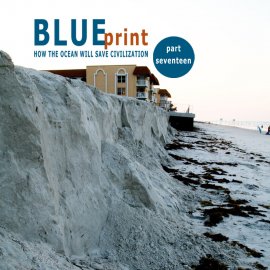Insurance and the Ocean
-
English
-
ListenPause
[intro music] Welcome to World Ocean Radio… I’m Peter Neill, Director of the World Ocean Observatory. If investment is risk, then insurance is a means by which to diminish the damage from unforeseen events, liability, and damage to come. And then there is re-insurance, the insuring of the insurers so that they, too, have coverage to mitigate further the consequence of claims to be paid. It seems complicated, and consumer understanding of insurance is a challenge, a surfeit of fine print we don’t often read until an accident forces the application of terms and payments upon us in the context of distress and need. But, actuarily, insurance is a simple equation: consumers pay premiums to companies that hold and invest those funds profitably until an untoward, actual event demands payments of claims, usually cumulatively, less payment outflow than premium inflow, generating profit for the company and its shareholders. The risk is further diminished by those companies insuring their risk in a similar exchange with the reinsurers and, in some cases, through government subsidies and reimbursements. Thus, it can be argued that insurance investment is no risk at all. The whole system is based on recovery or restoration from the consequence of risk and has become an integral part of protection against the probability of unforeseen challenges to personal health and injury, workplace compensation, property destruction, and liability claims that are adjudicated with penalties, or often settled, through lawyers or courts. We are required to purchase insurance, by law or by a need to avoid financial disaster by tort, legally defined as “an act or omission that gives rise to injury or harm to another and amounts to a civil wrong for which courts impose liability.” * In the United States, we live in a “tort storm” of claims, an integral part of our social/financial culture managed and sustained by a for-profit industry. Let’s take an ocean example. If you live on the coast, or inland in a floodplain, you are vulnerable to wind, rain, and wave from powerful storms alongshore. If your home is directly on the beach, you have coverage through the US Federal Emergency Management Agency, the notorious FEMA which manages evacuations and protections and provides government-subsidized insurance coverage for re-building. US taxpayers underwrite those costs over and above whatever coverage the homeowner may have. In some cases, areas and individual properties have been restored several times over in the same locale by this federal insurance program. However, if you live inland, even though subject to the same storm, you may not be FEMA covered and will need to insure restoration on your own, a distinction inequitable at best. Is it possible to conceive insurance another way? Instead of event restoration, could insurance be designed around risk prevention, where premiums are invested in systems that anticipate certain conditions in advance and finance protections that obviate the predictable damage, reduce disruption, and aggregate to larger strategies that reduce the overall cost of serial events? For example, FEMA has mandated that waterfront homes destroyed by storms be re-constructed at floor levels higher than historical or anticipated storm level rise, to apply such protections before rather than after the event. Could such requirements be built into zoning and building codes for vulnerable areas? Could bank loans be approved only when such risk protections are built in to home or business loans? Could funds be directed to infrastructure improvements in areas of high risk that will adapt more effectively to anticipated conditions – erosion protection, drainage directions, catchment basins, raised bridges and roads, restoration of natural shoreline barriers – all proven defenses paid for in advance of the cost of any single event or more financially recurring, debilitating events in the same area? Could insurance companies invest their premiums in novel financial instruments – stocks and mutual funds, bonds and venture technologies and products – with climate-mitigating goods and services? Could those companies become agents of change, maintaining their essential purpose, not only through retro-action, but also pro-action that prevents or diminishes more predictable, destructive, and expensive outcomes? Insurance companies are solid, stolid, and fixed in their construct and behavior. The industry has worked well for many years of quiet profit, but like all such institutions these days, they are at risk through complacency and sufficiency and convention. Why would a re-insurer allow that to endure? What happens when events insured become so constant and devastating that there is no profit after all? Why would government accept such uncertainty and mandate response as, yes, an insurance policy against failed insurance? Why risk it? We will discuss these issues, and more, in future editions of World Ocean Radio. [outro music] *(Legal Information Institute, website definition).
This week on World Ocean Radio: part seventeen of the multi-part BLUEprint series. In this episode we ask a series of questions that challenge the current insurance system in the US, including a vision for a redesign built around risk prevention and for reinvestment of premiums in systems that anticipate disruption and aggregate to larger strategies that reduce costs overall.

The "BLUEprint Series: How the Ocean Will Save Civilization" outlines a new and sustainable path forward, with the ocean leading the way.
About World Ocean Radio
Since 2009, a weekly 5-minute podcast covering a broad spectrum of ocean issues from science and education to advocacy and exemplary projects. World Ocean Radio, a project of the World Ocean Observatory, is available for syndicated use at no cost by college and community radio stations worldwide. Contact [email protected] if you are interested in becoming an affiliate or know of a radio station that should be broadcasting these episodes each week.
- Login to post comments



